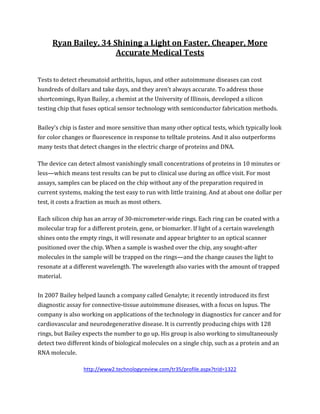
Ryan bailey
- 1. Ryan Bailey, 34 Shining a Light on Faster, Cheaper, More Accurate Medical Tests Tests to detect rheumatoid arthritis, lupus, and other autoimmune diseases can cost hundreds of dollars and take days, and they aren’t always accurate. To address those shortcomings, Ryan Bailey, a chemist at the University of Illinois, developed a silicon testing chip that fuses optical sensor technology with semiconductor fabrication methods. Bailey’s chip is faster and more sensitive than many other optical tests, which typically look for color changes or fluorescence in response to telltale proteins. And it also outperforms many tests that detect changes in the electric charge of proteins and DNA. The device can detect almost vanishingly small concentrations of proteins in 10 minutes or less—which means test results can be put to clinical use during an office visit. For most assays, samples can be placed on the chip without any of the preparation required in current systems, making the test easy to run with little training. And at about one dollar per test, it costs a fraction as much as most others. Each silicon chip has an array of 30-micrometer-wide rings. Each ring can be coated with a molecular trap for a different protein, gene, or biomarker. If light of a certain wavelength shines onto the empty rings, it will resonate and appear brighter to an optical scanner positioned over the chip. When a sample is washed over the chip, any sought-after molecules in the sample will be trapped on the rings—and the change causes the light to resonate at a different wavelength. The wavelength also varies with the amount of trapped material. In 2007 Bailey helped launch a company called Genalyte; it recently introduced its first diagnostic assay for connective-tissue autoimmune diseases, with a focus on lupus. The company is also working on applications of the technology in diagnostics for cancer and for cardiovascular and neurodegenerative disease. It is currently producing chips with 128 rings, but Bailey expects the number to go up. His group is also working to simultaneously detect two different kinds of biological molecules on a single chip, such as a protein and an RNA molecule. http://www2.technologyreview.com/tr35/profile.aspx?trid=1322